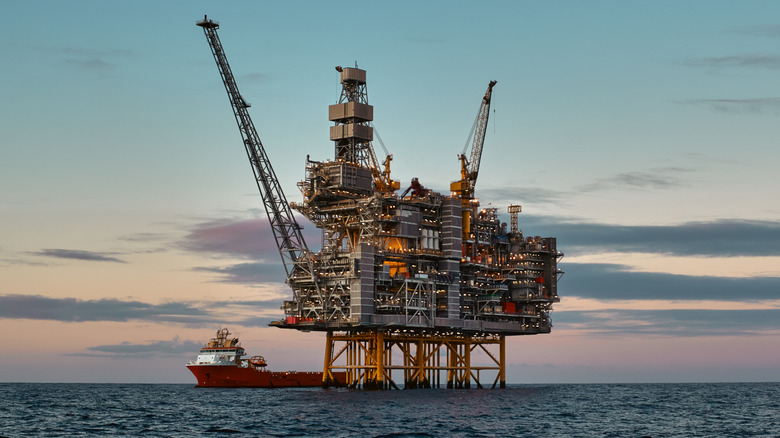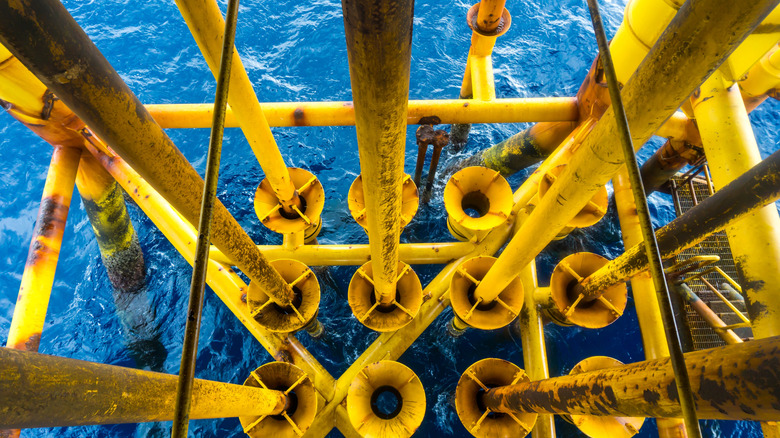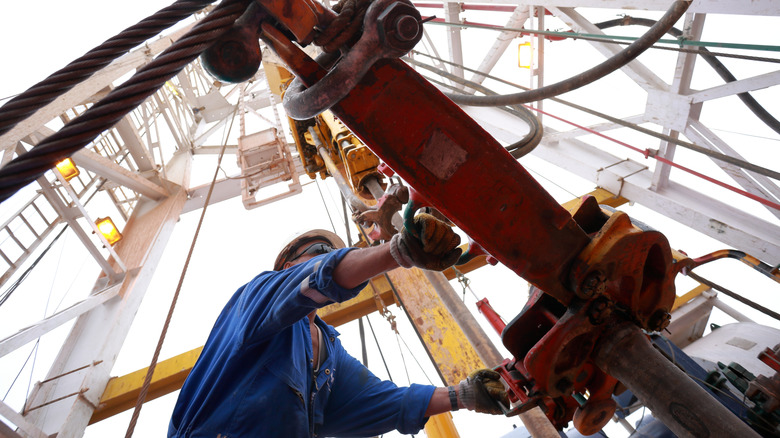Where Is The Largest Oil Rig In The World?
When you think about offshore oil rigs, what comes to mind is what you may have seen in movies — skeletal towers in the middle of a vast sea, some flares cutting through the darkness, and a crew that goes months without a sight of land. Such images do well to paint the picture, but they don't always show how enormous these machines really are.
Far from any coastline, in the icy waters of Russia's Far East, specifically in the Sea of Okhotsk and close to Sakhalin Island, sits the Pacific Berkut (which translates to "golden eagle" in Russian), an offshore oil rig built for Arctic oil and gas operations. This $12 billion station is surrounded by freezing waters, sometimes reaching as low as -47 degrees Fahrenheit, cold enough to test both the crew and steel alike.
Spanning over 344 feet long, 196 feet wide, 472 feet tall, and weighing a whopping 200,000 tons, it's easily one of the largest drilling rigs ever built. And being a gravity-based structure (GBS), it's anchored to the seabed and designed to withstand waves as tall as 60 feet and winds of up to 75 miles per hour, among other subarctic conditions. The rig is co-owned by several big oil companies from Russia, the U.S., India, and Japan under a consortium known as the Sakhalin-1, which was at some point the largest foreign direct investment in Russia.
How much oil does the Berkut oil rig produce?
The Pacific Berkut's enormous size isn't just for show — it's also a highly productive oil platform, able to produce up to 4.5 million tons of oil per year. When operating at full capacity, that works out to about 35 million barrels per year or nearly 96,000 barrels per day. Even so, a great deal of the crude oil extracted here is for export, particularly to the Asia-Pacific region, which boasts undersea pipelines for transport.
Achieving such production levels is no child's play, especially in the Sea of Okhotsk, where the waters experience frequent storms, and let's not even get started on how thick the ice gets during winter over there; sometimes up to 6 feet thick. However, thanks to its reinforced structure and ice-resistant systems to prevent blockages in pipelines and equipment, the Berkut is Arctic-ready by design to ensure drilling and extraction can go on all year round, no matter how hostile the weather gets.
How does the Berkut oil rig work?
To understand how the Pacific Berkut works, picture a mega-factory planted on the seabed in the middle of the sea. In this case, think drilling equipment, a processing unit, support and security systems, living quarters for the crew, emergency equipment, a helipad, and other facilities, all on one platform.
As for drilling operations, it all starts with a derrick (not your buddy Derrick) — the tall structure that holds the drilling equipment. The derrick lowers drill strings through 115 feet of seawater to the seabed, then drills several miles down into oil-bearing rock formations. Powerful pumps then circulate drilling mud, which cools the drill bit and stabilizes the wellbore, as well as carry cuttings to the surface.
Once the crude reaches up top, it goes straight to the processing units that separate it from gas and water, after which it's then sent through undersea pipelines to shore facilities responsible for storage and preparation for export. The number of people who work on an offshore oil rig varies depending on its size. On Pacific Berkut, there's a rotating crew of 200 who lives on board for 4 weeks at a time, with the sole aim of keeping drilling and processing operations running around the clock. Keeping such a formidable offshore installation running is a complex operation, to say the least, but it's what makes the Pacific Berkut operate in an environment where other rigs could barely survive, let alone thrive.


